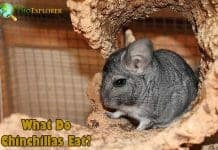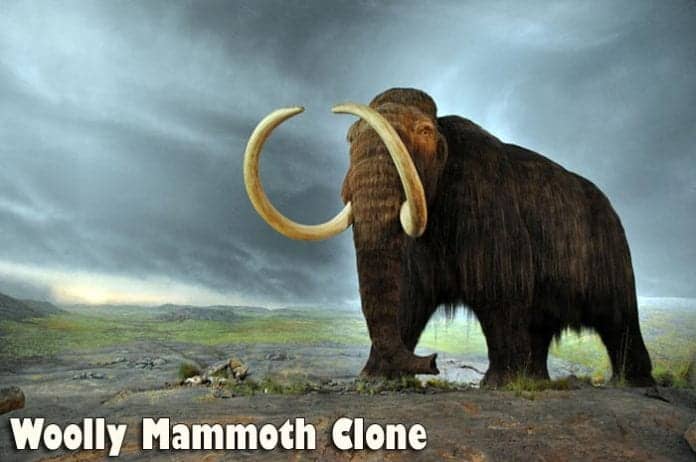
Woolly Mammoth Clone: According to studies, the planet is now in the midst of mass extinction for the sixth time, with the fifth one being the extinction of dinosaurs. About 30 to 160 species seem to vanish every passing day thanks to perilous anthropogenic activities.
Since 1500, an estimate of more than 300 animal species (e.g., birds, mammals, amphibians and reptiles) has already disappeared. While the number is still not specific, many scientists think that the rate of species disappearance is the greatest in the Earth’s history.
However, what do you think will happen if extinction can be prevented? What will happen if lost species can be again brought back to life?
For many years now, the idea of resurrecting or reviving animals from extinction has always been the aim of numerous scientific studies. With the advancement of technology, this dream is now speeding closer to being a reality.
Among many species in the animal kingdom, the Woolly Mammoth and the Passenger Pigeon are the top priority. These two species were once functionally distinct, and after their extinction, the habitats they once lived in changed drastically.
On this page, we will explore the large hairy Woolly Mammoth and the studies being done concerning it. Extinct for thousands of years, can the Woolly Mammoth be resurrected?
Wouldn’t this be fascinating? Moreover, how much would a phenomenon in science will this be?
Table of Contents
- What exactly is a Woolly Mammoth?
- The Woolly Mammoth Clone Project
- Woolly Mammoth DNA
- What is the goal of the revival?
- The Drawbacks of the Woolly Mammoth Revival
- Frequently Asked Questions
- Has a woolly mammoth been cloned?
- Are we bringing back the woolly mammoth?
- Is there any woolly mammoth DNA?
- Is it possible to clone and bring back extinct animals, such as woolly mammoths?
What exactly is a Woolly Mammoth?
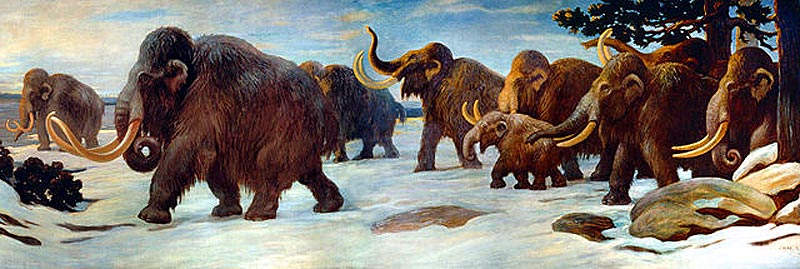
Woolly Mammoths (Mammuthus primigenius) were elephant-like creatures that lived more than 120,000 years ago (from Pleistocene epoch to Holocene epoch), long after the dinosaurs went extinct.
Woolly Mammoths are believed to share a common ancestor with modern-day elephants, only that the former is more adapted to colder climates. However, the exact phylogeny and how divergence occurred over time is still not elucidated.
- During the ice ages, the Woolly Mammoth is believed to thrive in the steppe grasslands of North America over the land bridge of Beringia.
- Like other herbivores, the Woolly Mammoth helped maintain the grasslands in the ancient Arctic ecosystems. They do this explicitly by running into trees and dispersing grass seeds in their fecal matter.
- When they disappeared, the grasslands turned into the modern-day mossy taiga and tundra ecosystems, which are now starting to melt and liberate carbon dioxide in the atmosphere. Scientists think that the tundra ecosystems have the highest carbon risk among all of the forests in the world combined.
- Interestingly, humans have witnessed the existence of the Woolly Mammoths as numerous cave paintings of them have been found in Spain and France.
- Also, mammoth bones were used to create tools during burial ceremonies. However, except for fossils preserved in ice, the Woolly Mammoth is now extinct.
![]()
The Woolly Mammoth Clone Project
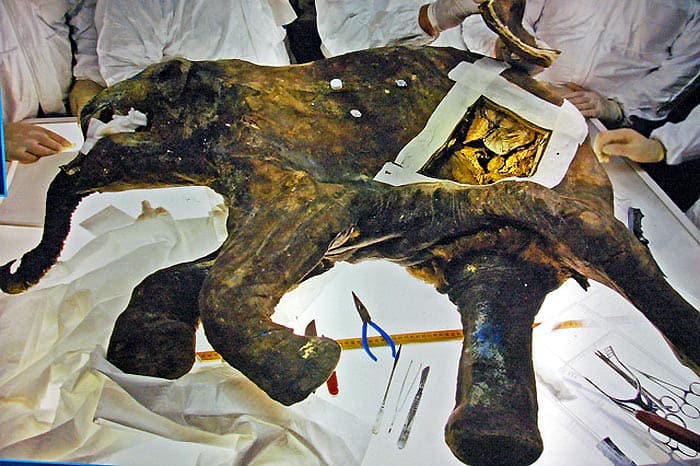
Known as the Woolly Mammoth Project, the de-extinction project is spearheaded by a Harvard-based team with Dr.George Church as the team leader. The cloning process will utilize the CRISPR genetic engineering process to copy and paste Mammoth genetic material into live fibroblast cell cultures from elephants.
- At present, numerous Mammoth genes have already been encoded into elephant cell lines, which resulted in some already “mammoth-like” cells.
- Aside from that, the genetic engineering of various character traits like hemoglobin production, adipose tissue production, hair growth, and adaptation to cold climates have already been encoded in the fibroblast cell lines.
- After that, the said cell lines will be engineered to become cells known as induced pluripotent stem cells (iPSCs). These cells, also known as “immortal cells,” will be used to create cells from three primary body layers and can eventually generate cells and tissues on their own.
- The Woolly Mammoth stem cells will be used to create cells to study the mutation effects on the character above traits.
- When the traits have successfully been incorporated into the tissues, the next step in the cloning process would be the generation of embryos using stem cell embryogenesis. An artificial womb/uterus will carry the Woolly Mammoth embryo. In particular, Asian elephants will be surrogate mothers to gestate the embryos.
- While the said plan may appear seemingly impossible, two previous scientific discoveries have paved the way for the development of this present study. Such breakthroughs include the transfer of fetal lambs to artificial lambs and the healthy birth offspring from the 3D-printed ovaries of infertile mice.
- According to the scientists, once embryos have been successfully produced, young cloned Woolly Mammoths will be grown in cold temperatures to prepare for their living in the wild.
- Moreover, once a stable population of clone mammoths has been obtained, the group will be placed in the identified restoration sites in the Arctic, particularly in Siberia.
![]()
Woolly Mammoth DNA
To get a hold of the Woolly Mammoth DNA, scientists, before this current project, obtained bones from a Woolly Mammoth that existed more than 12,000 years ago. After that, DNA fragments from the bones were amplified to generate numerous copies of the target genes.
Fortunately, many of these DNA fragments overlapped, so scientists could get a picture of what the genome looks like. The results of the analyses showed that the Woolly Mammoth has more than 95.8% similarities with the modern-day Asian elephant.
- Despite these vast similarities, scientists believe that more than 2,000 genetic mutations (i.e., non-protein coding ones) have been expressed in modern-day elephants. Furthermore, they think that some of these mutations include the character trait of adaptation to cold climates.
- While genetic material has already been obtained from the Woolly Mammoth, one major dilemma of this project is the absence of viable DNA for cloning. Because of being frozen for long periods, some DNA has already been degraded or trimmed.
- The Scientists have figured out how to solve this problem: altering the modern-day elephant genome to recreate the mammoth genome. With this, of course, the resulting product will not be precisely identical to the extinct one but undoubtedly closely related.
![]()
What is the goal of the revival?
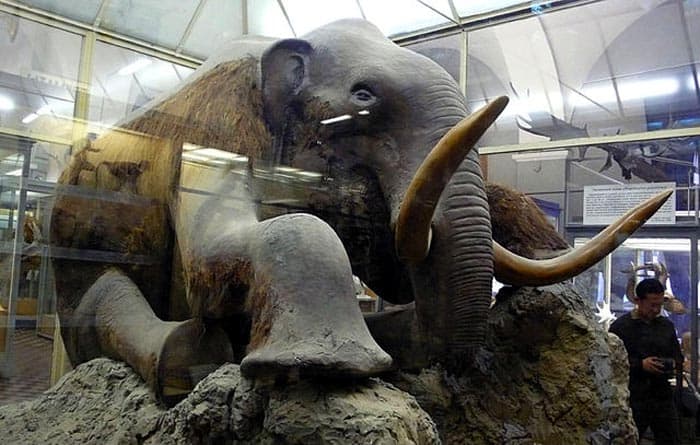
As the developments and innovations in the field of biotechnology continue to increase, the idea of reviving an extinct species may come true in the future. The Woolly Mammoth is an ideal species to be resurrected because some intact mammoth fossils are still available, and it still has close living relatives.
- In this scientific endeavor, scientists and researchers want to learn the ways of nature and make artificial living organisms using synthetic biology. Many scientists believe the genetic material of prehistoric animals to be important records of information about adaptation and evolution.
- To do this, an organism’s character traits expressed in the cells, tissues, as well as behavior needs to be studied.
- In the case of extinct animals, “de-extinction” will allow the study of prehistoric data where the mere identification of the genome cannot give. In particular, the information about the Woolly Mammoth blood will give important data about the adaptation of mammalian blood to survive in cold climates. Such knowledge will be beneficial in the study of diseases in humans.
- Ultimately, the goal of this “de-extinction” project is for species to re-populate the boreal and tundra forests of North America, Europe, and Asia. The goal is not to create exact copies of the extinct Woolly Mammoth but to observe the adaptations of these organisms to survive in cold climates. The knowledge of such will be beneficial in the conservation and preservation of the population of elephants in Asia.
![]()
The Drawbacks of the Woolly Mammoth Revival
Of course, when there are advantages, there are also disadvantages attached to the revival of the Woolly Mammoth. One of the biggest enemies of animal cloning is ethics. Like any other scientific procedure involving the manipulation of natural creation, de-extinction via the cloning process is deemed unethical and contrary to many people’s religious and moral views.
- Another challenge to this process is the difference between the kinds of environments where these species once thrived and the environments we have now.
- Critics of these kinds of de-extinction projects believe that rather than focusing on the reviving of long-dead species, modern-day technologies should center more on the conservation and restoration of living organisms and endangered ones.
![]()
Indeed, reviving a living organism is very difficult, if not impossible. While the Woolly Mammoth is an ideal candidate for this, there are still ongoing debates about whether doing such is possible. On the other hand, some believe that reviving species is no longer considered a “what if” but rather a “when” question.
However, can the resurrection of the Woolly Mammoth bring good to humanity, or will it just cause the other way around? What do you think?
![]()
Frequently Asked Questions
Has a woolly mammoth been cloned?
No viable mammoth tissue or intact genome has been found for cloning. Despite this, various methods like cloning, artificial insemination, and genome editing have been proposed.
- In 2019, scientists from Japan and Russia managed to recover cells from a juvenile mammoth found in Siberian permafrost, successfully implanting cell nuclei in mouse cells, indicating biological activity.
- In 2021, a company was launched to restore the woolly mammoth to the Arctic tundra by genetically engineering Asian elephants to create modern-day “mammoths.”
- The company plans to edit genes to create a woolly mammoth embryo, which will be placed in an African elephant. However, the ethics of reviving the mammoth have sparked disagreements.
Are we bringing back the woolly mammoth?
While no woolly mammoth has been cloned yet, efforts are underway to achieve this. Colossal Biosciences, a de-extinction company, is working on creating mammoths in labs and plans to release them in a Siberian Park.
- This is done by editing the genes of Asian elephants. In 2019, scientists from Japan and Russia recovered cells from a juvenile mammoth, successfully implanting the cell nuclei in mouse cells, indicating biological activity.
- With recent funding of $60 million, Colossal aims for a 2027 de-extinction of the woolly mammoth. However, this plan has raised concerns about the ecological impact, the use of surrogate mother elephants, and the ethical considerations of reviving extinct species.
Is there any woolly mammoth DNA?
Woolly mammoth DNA has been sequenced by scientists from DNA extracted from frozen soft-tissue remains.
- The DNA of the woolly mammoth is a 99.6 percent match with the Asian elephant, which bolsters the confidence of Colossal, a de-extinction company, in achieving its goal.
- Scientists have identified key differences between these extinct animals and elephants by analyzing the genomes of woolly mammoths from fossils.
- They have pinpointed 60 genes that are believed to be crucial to the distinctive traits of mammoths, such as their hair, fat, and unique characteristics.
Is it possible to clone and bring back extinct animals, such as woolly mammoths?
As explained earlier, several methods exist for potentially resurrecting extinct animals, including woolly mammoths, such as cloning, artificial insemination, and genome editing.
- Cloning, which produces an identical organism, requires intact living cells, making it suitable only for species nearing extinction.
- Selective back-breeding involves breeding subjects carrying ancient traits from related extinct species. On the other hand, genome editing creates hybrids by inserting edited DNA from an extinct species into a reproducing cell, allowing for the resurrection of species even with poorly preserved remains.
- This results in a hybrid organism with unique traits from the extinct species. However, reintroducing these species may not yield positive environmental benefits, as their roles in the ecosystem may have changed since their extinction.
![]()





